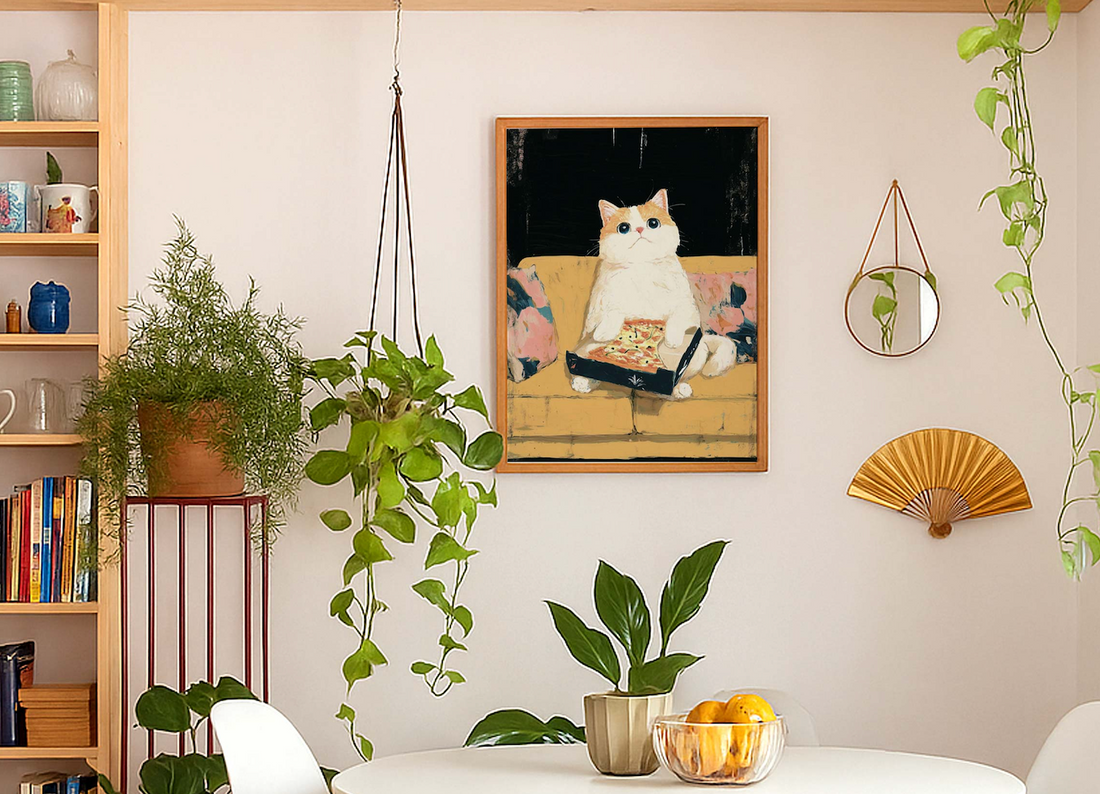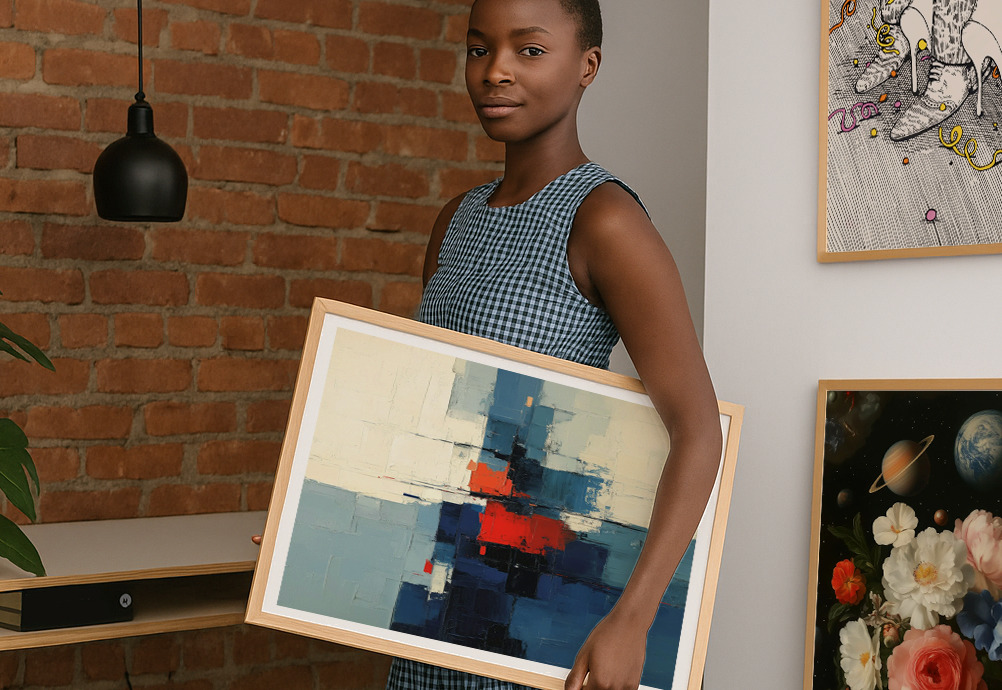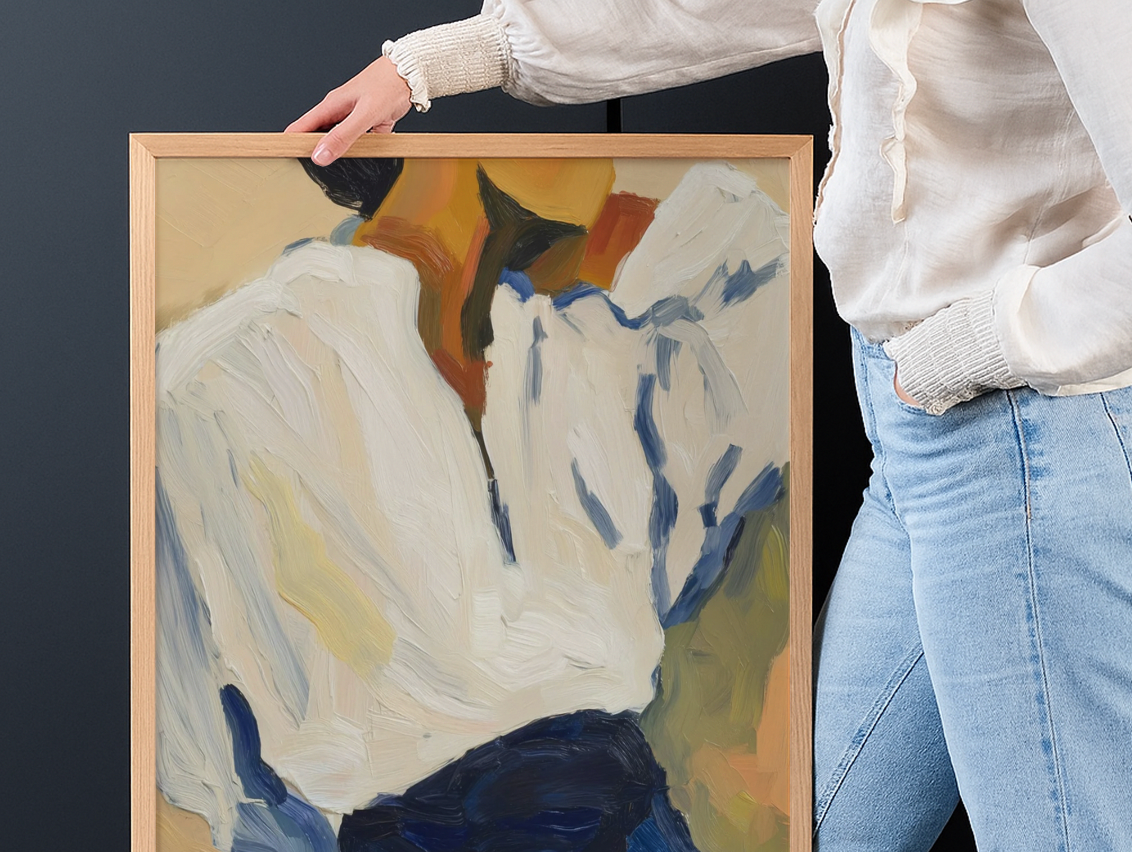The 57-Inch Rule: Perfect Art Hanging Height Explained
The simple height rule galleries use — and how to make it work in your home (or break it on purpose).

Most people hang their art too high. Walk into any home and you'll see it: prints floating near the ceiling, looking lost and disconnected from everything below.
There's a simple fix. Galleries figured this out decades ago, and it works just as well in your living room.
What is the 57-inch rule?
The center of your artwork should sit 57 inches from the floor. That's it.
Not the top of the frame. Not the bottom. The center. Whether you're hanging a tiny print or a massive canvas, put the middle point at 57 inches up.
This height puts art at average eye level for most adults. When you walk into a room, your eyes naturally land right where the art is. No craning your neck up or looking down.
The result? Your space feels balanced and intentional. Like someone who knows what they're doing lives there.

Why 57 inches works
This isn't some arbitrary number. It's based on how people actually see and move through spaces.
Most adults stand between 5'4" and 6'2". Eye level for this range falls around 57 to 65 inches. So 57 inches hits the sweet spot where most people will naturally look.
When art hangs at this height, it creates visual weight at the right level. Too high, and it feels disconnected from your furniture and the rest of the room. Too low, and it gets lost.
Museums and galleries use this standard because it works across different ceiling heights and room sizes. As Emily Santangelo notes, "When a client takes the time to search for a great work of art that both complements the space and makes them feel good, the result is a home that looks effortlessly put together and comes alive."
How to measure it
Here's the math, but don't let it scare you off.
Say your print is 16 inches tall. Half of that is 8 inches. So you want the center to sit at 57 inches, which means the top of your print should be at 65 inches (57 + 8 = 65).
For a 24-inch tall piece, the center is 12 inches from the top. Top of the frame goes at 69 inches.
But honestly? You don't need to get out the calculator every time. Once you hang a few pieces at this height, your eye starts to know what looks right.

When to follow the rule
The 57-inch rule works best for standalone pieces on empty walls. Think about your entryway, the wall above your sofa, or any place where art is the main event.
It's especially good for pieces you want people to really look at. When art hangs at natural eye level, people actually stop and notice it instead of glancing past.
The rule also helps when you're hanging multiple pieces in the same room. Keep them all at 57 inches, and everything feels cohesive without being matchy-matchy.
When to ignore the rule
Rules are made for breaking, especially in your own home.
If you're hanging art above furniture, forget 57 inches. You want 6 to 12 inches of space between the top of your sofa or dresser and the bottom of your frame. Otherwise, the art looks like it's floating in space.
How to Arrange Art Above Furniture covers this in detail, but the basic idea is that art and furniture should feel connected, not separated.
Gallery walls have their own logic too. The rule here is visual balance, not precise measurements. Start with your largest piece around 57 inches, then build around it based on what looks good.
Kids' rooms call for kid-height art. A 57-inch center point puts art way above where children actually look. Drop it down so they can see and enjoy it.
And sometimes you just like how something looks at a different height. Trust that instinct.
The eye test
Here's how to check if your art height feels right without measuring anything.
Stand in the doorway and look at the wall. Does the art feel like it belongs with the rest of the room? Or does it look like it's trying to escape to the ceiling?
Walk up close to the piece. Can you look at it comfortably without tilting your head up or down? If you feel like you're looking up at it, it's probably too high.
Step back to where you'd normally be in the room. Does the art feel connected to your furniture and the space around it? Good art should anchor a space, not float above it.
Making it work in real rooms
Real homes have quirks that galleries don't. Low ceilings, weird layouts, furniture that doesn't fit the rules.
In rooms with 8-foot ceilings, 57 inches might feel too high. Try 52 or 54 inches instead. The goal is proportion, not perfection.
If you have really tall ceilings, 57 inches might look too low. You can go higher, but be careful. Once you get much above 60 inches, art starts to feel disconnected from the room.
For art in hallways or narrow spaces, stick close to 57 inches. People walk through these spaces standing up, so standard eye level works well.
When size changes everything
The 57-inch rule assumes normal-sized art, roughly 16 to 40 inches in any direction.
For really large pieces, you might need to adjust. A massive 60-inch canvas hung with its center at 57 inches puts the bottom at 27 inches from the floor. That might feel too low, especially if you have furniture nearby.
Tiny pieces follow different rules too. A small 8x10 print with its center at 57 inches can get lost on a big wall. Sometimes grouping small pieces together works better than following the height rule exactly.
As Anastasia Casey of The Interior Collective points out, "As for size, I always opt for larger pieces in smaller spaces; it may feel counterintuitive, but it makes a tight space feel larger."
Getting started
Pick one piece and try the 57-inch rule. Live with it for a few days. Does it feel right when you walk into the room? When you're sitting on the sofa? When you're standing and talking?
If it works, great. Use that as your baseline for other pieces in the same space.
If it feels off, adjust up or down until it looks right to you. The point isn't to follow rules perfectly. It's to have a confident starting point.
Mistakes to Avoid When Buying Wall Art talks about common placement errors, but the biggest one is overthinking it. Art should make you happy, not stressed about measurements.
Trust your eyes
The 57-inch rule is a tool, not a law. It gives you a place to start when you're staring at a blank wall with a hammer in your hand.
But your room is unique. Your furniture is different. Your ceiling height might be unusual. And your taste matters more than any gallery standard.
Use 57 inches as a starting point, then trust what looks good to you. As Frieda Gormley notes, "So we say never hold back with the personal objects, mementos, pictures and paintings that evoke a memory or a story, as those are the things that transform a house into a home."
The best-hung art is the kind that makes you smile every time you see it, whether it's at 57 inches or 52 or 62.
How to Choose the Right Art for Your Home covers the bigger picture of picking pieces that work in your space. But once you've found art you love, hanging it at the right height lets it do what it's supposed to do: make your home feel more like you.
Ready to find pieces that deserve the perfect spot on your wall? Explore prints that work at any height.
Fab products featured in this blog
-
Lemon Grove Brunch View Canvas Print
Translation missing: en.products.product.sale_price From €64,95€91,95 -
Blush Stripes Muse Art Print
Translation missing: en.products.product.sale_price From €16,95€22,95 -
Cozy Cat Pizza Night Art Print
Translation missing: en.products.product.sale_price From €16,95€22,95 -
Blue Nude by Henri Matisse Art Print
Translation missing: en.products.product.sale_price From €16,95€22,95 -
The Goldfish by Henri Matisse Art Print
Translation missing: en.products.product.sale_price From €16,95€22,95 -
Art The Kiss, Gustav Klimt Inspired Art Print
From €22,95
More from The Frame
More stories, insights, and behind-the-scenes looks at the art that transforms your space
Top Wall Art Trends for 2025: What's In, What's...
Trends aren't rules to follow blindly. They're signals about where our collective taste is heading, what's capturing our imagination, and what feels fresh right now. The wall art trending in...
Art for Gifting: How to Choose a Print for Some...
Giving someone art is either incredibly thoughtful or slightly terrifying. There's no middle ground. On one hand, you're giving them something beautiful that will live in their home for years....
9 Art Prints That Instantly Elevate Any Living ...
You know that feeling when you walk into a beautifully styled living room and everything just feels right? It's not the expensive sofa or the perfect rug. It's usually the...













